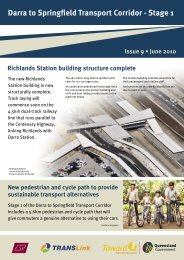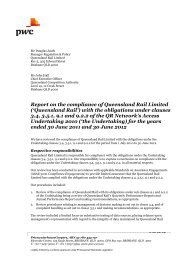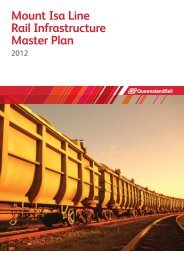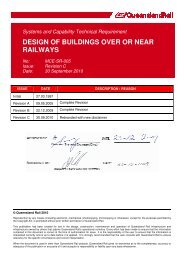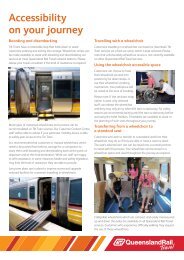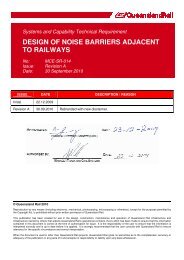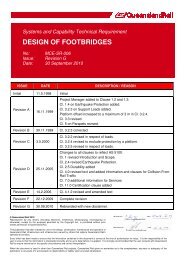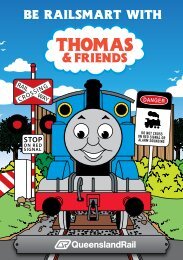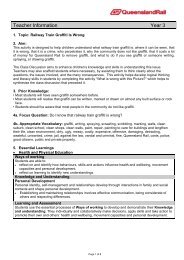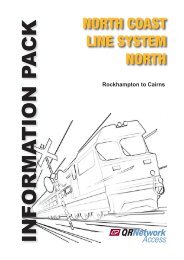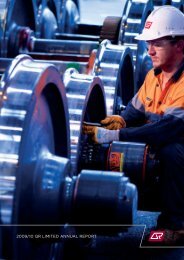CIVIL-SR-002 - Queensland Rail
CIVIL-SR-002 - Queensland Rail
CIVIL-SR-002 - Queensland Rail
You also want an ePaper? Increase the reach of your titles
YUMPU automatically turns print PDFs into web optimized ePapers that Google loves.
Civil Engineering Technical Requirement<br />
<strong>CIVIL</strong>-<strong>SR</strong>-<strong>002</strong><br />
WORK IN OR ABOUT QUEENSLAND<br />
RAIL PROPERTY<br />
Revision: G<br />
Updated: 30 May 11<br />
© <strong>Queensland</strong> <strong>Rail</strong> 2010<br />
Reproduction by any means (including electronic, mechanical, photocopying, microcopying or otherwise), except for the purposes<br />
permitted by the Copyright Act, is prohibited without prior written permission of <strong>Queensland</strong> <strong>Rail</strong>.<br />
This publication has been created for use in the design, construction, maintenance and operation of <strong>Queensland</strong> <strong>Rail</strong> infrastructure and<br />
infrastructure owned by others that adjoins <strong>Queensland</strong> <strong>Rail</strong>'s operational corridors. Every effort has been made to ensure that the<br />
information contained in this document is correct at the time of authorisation for issue. It is the responsibility of the user to ensure that<br />
the information is interpreted correctly and is up to date before it is applied. It is strongly recommended that the user consults with<br />
<strong>Queensland</strong> <strong>Rail</strong> to ensure relevancy for the specific circumstance and correct interpretation.<br />
When the document is used in other than <strong>Queensland</strong> <strong>Rail</strong> projects, <strong>Queensland</strong> <strong>Rail</strong> gives no warranties as to the completeness;<br />
accuracy or adequacy of the publication or any parts of it and accepts no responsibility or liability upon any basis whatsoever.
<strong>CIVIL</strong>-<strong>SR</strong>-<strong>002</strong> (Revision G)<br />
Document Information<br />
Current Revision:<br />
G<br />
First Released: 05/03/1997<br />
Last Updated: 30 May 2011<br />
Review Before: 30 May 2014<br />
Approved by:<br />
Authorised by:<br />
Ian McColl<br />
Chris Keye<br />
Document Amendment History<br />
Revision<br />
Date<br />
Section(s)<br />
Amended<br />
Summary of Amendment<br />
Initial 05/03/1997<br />
A 14/05/1997 Minor editing prior to authorisation<br />
B<br />
16/01/2001<br />
QUEENSLAND RAIL costs updated<br />
Definition of terms altered<br />
C 04/02/2<strong>002</strong> Safety Induction course costs updated<br />
D 30/06/2005 Definition of Terms altered<br />
E 22/12/2009 Complete Revision<br />
F 30/09/2010 New disclaimer. Rebranded.<br />
G<br />
30/05/2011<br />
Clauses 8, 9 and 10 removed. Title changed from MCE to<br />
<strong>CIVIL</strong><br />
© 2010 <strong>Queensland</strong> <strong>Rail</strong> Limited UNCONTROLLED COPY WHEN PRINTED Page 1 of 2
<strong>CIVIL</strong>-<strong>SR</strong>-<strong>002</strong> (Revision G)<br />
TABLE OF CONTENTS<br />
1.0 INTRODUCTION ................................................................................................................................. 3<br />
1.1 Scope .............................................................................................................................. 3<br />
1.2 Definition of Terms .......................................................................................................... 3<br />
1.3 QUEENSLAND RAIL Corridor Safety ............................................................................. 3<br />
1.4 Safety Clothing ................................................................................................................ 4<br />
1.5 Work Authorisation ......................................................................................................... 4<br />
2.0 CONSTRUCTION METHODS ............................................................................................................ 4<br />
2.1 General ........................................................................................................................... 4<br />
2.2 Interfering with a <strong>Rail</strong>way ................................................................................................ 4<br />
2.3 Environmental Management Plan ................................................................................... 4<br />
2.4 Track Protection Coordinator / Officer (TPC/TPO) ......................................................... 5<br />
2.5 Project Manager.............................................................................................................. 5<br />
2.6 Construction Procedure .................................................................................................. 5<br />
2.7 Track Clearances ............................................................................................................ 5<br />
2.8 Track Possession ........................................................................................................... 5<br />
2.9 Delays to Trains .............................................................................................................. 6<br />
2.10 Stopping Work ................................................................................................................ 6<br />
2.11 Removal of Contractor’s Employee ................................................................................ 6<br />
2.12 Temporary Level Crossings ............................................................................................ 6<br />
2.13 Excavation near a <strong>Rail</strong>way Track .................................................................................... 7<br />
2.14 Blasting ........................................................................................................................... 7<br />
2.15 Construction Plan ............................................................................................................ 7<br />
3.0 RELOCATION OR ALTERATION OF RAILWAY SERVICES ........................................................... 7<br />
4.0 WORKS AREAS ON RAILWAY LAND .............................................................................................. 7<br />
5.0 DEMOLITION OF EXISTING STRUCTURE ...................................................................................... 8<br />
6.0 REMOVAL AND RE-ERECTING OF FENCING ................................................................................. 8<br />
7.0 REMOVAL OF BUILDINGS AND CLEANING UP ............................................................................. 8<br />
Page<br />
© 2010 <strong>Queensland</strong> <strong>Rail</strong> Limited UNCONTROLLED COPY WHEN PRINTED Page 2 of 2
<strong>CIVIL</strong>-<strong>SR</strong>-<strong>002</strong> (Revision G)<br />
1.0 INTRODUCTION<br />
This Technical Requirement details the criteria<br />
which must be met by an external party working in<br />
or about <strong>Queensland</strong> <strong>Rail</strong> property. Reference is<br />
made to the following additional <strong>Queensland</strong> <strong>Rail</strong><br />
Technical Requirements which must also be<br />
satisfied:<br />
<br />
<strong>CIVIL</strong>-<strong>SR</strong>-003 Work adjacent to overhead line<br />
equipment,<br />
A copy of this document may be obtained from<br />
<strong>Queensland</strong> <strong>Rail</strong>.<br />
All reference documents, e.g. Australian Standards,<br />
codes and <strong>Queensland</strong> <strong>Rail</strong> Technical<br />
Requirements, are to be the latest version.<br />
1.1 Scope<br />
This Technical Requirement specifies the<br />
requirements that a Contractor must comply with<br />
when working on:-<br />
<strong>Queensland</strong> <strong>Rail</strong> Property.<br />
In the vicinity of <strong>Queensland</strong> <strong>Rail</strong> property.<br />
Over or under <strong>Queensland</strong> <strong>Rail</strong> property.<br />
When working on or adjacent to electrified tracks<br />
these requirements need to be read in conjunction<br />
with the Technical Requirement <strong>CIVIL</strong>-<strong>SR</strong>-003<br />
“Work Adjacent to Overhead Line Equipment”.<br />
1.2 Definition of Terms<br />
I. "<strong>Queensland</strong> <strong>Rail</strong> ". <strong>Queensland</strong> <strong>Rail</strong> having<br />
its offices at 305 Edward Street, Brisbane,<br />
<strong>Queensland</strong>.<br />
II.<br />
III.<br />
“Track Protection Officer (TPO)”. The person<br />
appointed by <strong>Queensland</strong> <strong>Rail</strong> to protect the<br />
safe operation of the Operating <strong>Rail</strong>way and<br />
has the responsibility for liaising with Train<br />
Control (except where a TPC has been<br />
appointed) and arranging for the necessary<br />
track protection;<br />
“Track Protection Co-ordinator (TPC)”. The<br />
person appointed by <strong>Queensland</strong> <strong>Rail</strong> who has<br />
the overall responsibility for liaising with Train<br />
Control and arranging for the necessary track<br />
protection and safe working requirements. The<br />
TPC is to oversee and advise the Contractor<br />
on all railway safety requirements associated<br />
with the Works.<br />
IV.<br />
“Contractor”. The persons, firm, partnership,<br />
company or corporation carrying out work<br />
adjacent to or over electrified railway tracks,<br />
whether as a contract or as day labour. The<br />
word “Contractor” shall mean the Contractor,<br />
subcontractors of the Contractor, and suppliers<br />
and invitees of the Contractor.<br />
V. “<strong>Queensland</strong> <strong>Rail</strong> Property”. Property owned,<br />
leased or occupied by <strong>Queensland</strong> <strong>Rail</strong>.<br />
VI.<br />
VII.<br />
VIII.<br />
IX.<br />
“Operating <strong>Rail</strong>way”. The existing railway,<br />
which is in operation and includes but is not<br />
limited to fixed structures, installations,<br />
buildings and the like, as well as rollingstock<br />
and other equipment operating on the track.<br />
“Project Manager”. <strong>Queensland</strong> <strong>Rail</strong><br />
appointed representative to oversee and<br />
coordinate the works during planning, design,<br />
construction and post construction. This role<br />
may be carried out by the Contracts Engineer<br />
during the construction and post construction.<br />
“Operating Track”. A railway track over which<br />
trains and other track-mounted equipment may<br />
be operating.<br />
“Track Closure”. The closure of a section of<br />
the Operating Track to all rail traffic other than<br />
construction related rail traffic.<br />
X. “Track Possession”. The period within a Track<br />
Closure when the Contractor is authorised to<br />
carry out work over, under or adjacent to the<br />
closed operating track.<br />
XI.<br />
XII.<br />
“Work”. Work which could directly or indirectly<br />
affect <strong>Queensland</strong> <strong>Rail</strong> property and/or<br />
operations.<br />
“Work Site”. Each separate location where<br />
work is to be carried out over, under or<br />
adjacent to the Operating <strong>Rail</strong>way.<br />
1.3 QUEENSLAND RAIL Corridor Safety<br />
<strong>Queensland</strong> <strong>Rail</strong> corridor safety must be in<br />
accordance with <strong>Queensland</strong> <strong>Rail</strong> Multi Business<br />
Instruction NET-MUL-BI-6001 – “Access to the<br />
<strong>Queensland</strong> <strong>Rail</strong> network rail corridor”. These<br />
requirements must apply to all persons entering the<br />
rail corridor, including all visitors, vendors and<br />
suppliers to the worksite.<br />
© <strong>Queensland</strong> <strong>Rail</strong> 2010<br />
Reproduction by any means (including electronic, mechanical, photocopying, microcopying or otherwise), except for the purposes permitted<br />
by the Copyright Act, is prohibited without prior written permission of <strong>Queensland</strong> <strong>Rail</strong>.<br />
This publication has been created for use in the design, construction, maintenance and operation of <strong>Queensland</strong> <strong>Rail</strong> infrastructure and<br />
infrastructure owned by others that adjoins <strong>Queensland</strong> <strong>Rail</strong>'s operational corridors. Every effort has been made to ensure that the<br />
information contained in this document is correct at the time of authorisation for issue. It is the responsibility of the user to ensure that the<br />
information is interpreted correctly and is up to date before it is applied. It is strongly recommended that the user consults with <strong>Queensland</strong><br />
<strong>Rail</strong> to ensure relevancy for the specific circumstance and correct interpretation.<br />
When the document is used in other than <strong>Queensland</strong> <strong>Rail</strong> projects, <strong>Queensland</strong> <strong>Rail</strong> gives no warranties as to the completeness;<br />
accuracy or adequacy of the publication or any parts of it and accepts no responsibility or liability upon any basis whatsoever.
<strong>CIVIL</strong>-<strong>SR</strong>-<strong>002</strong> (Revision G)<br />
No one can enter the rail corridor without being<br />
supervised by a <strong>Queensland</strong> <strong>Rail</strong> qualified Track<br />
Protection Officer or being accredited as a<br />
<strong>Queensland</strong> <strong>Rail</strong> qualified Track Protection Officer.<br />
All planned work within the rail corridor requires a<br />
written and approved Corridor Access Safety Plan<br />
(SW61), developed prior to entering the corridor, by<br />
the worksite <strong>Queensland</strong> <strong>Rail</strong> Track Protection<br />
Officer and the Worksite Supervisor. The<br />
Contractor/Worksite Supervisor must contact<br />
<strong>Queensland</strong> <strong>Rail</strong> prior to planning to enter the rail<br />
corridor, to arrange for a worksite assessment of<br />
the <strong>Queensland</strong> <strong>Rail</strong> corridor safety requirements,<br />
by a <strong>Queensland</strong> <strong>Rail</strong> Track Protection Officer.<br />
The Contractor shall be responsible for ensuring<br />
that all staff, employees and all other persons for<br />
whom the Contractor is responsible are fully<br />
informed of the dangers and procedures while<br />
working near existing railway tracks and overhead<br />
traction wiring equipment.<br />
1.4 Safety Clothing<br />
The Contractor shall ensure that all employees,<br />
visitors and other personnel employed or present on<br />
railway property in areas generally excluded from<br />
the public, shall at all times wear high viz orange<br />
shirts or safety vests, in accordance with<br />
<strong>Queensland</strong> <strong>Rail</strong> safety standard<br />
SAF/STD/0032/SWK/NET. Where work is to be<br />
carried out at night or in reduced visibility, all shall<br />
wear reflectorised orange safety shirts or vests, in<br />
accordance with <strong>Queensland</strong> <strong>Rail</strong>’s requirements.<br />
The Contractor shall ensure that no red or green<br />
clothing, including hats and safety helmets, shall be<br />
permitted to be worn by any employee, visitor or<br />
other personnel of the Contractor while on railway<br />
property, in areas generally excluded from the<br />
public.<br />
1.5 Work Authorisation<br />
Work shall be carried out to the satisfaction of<br />
<strong>Queensland</strong> <strong>Rail</strong> or a <strong>Queensland</strong> <strong>Rail</strong> appointed<br />
Project Manager.<br />
All work performed on <strong>Queensland</strong> <strong>Rail</strong> property or<br />
when directed by <strong>Queensland</strong> <strong>Rail</strong> shall be under<br />
the supervision of a TPC or TPO and shall be<br />
carried out only at times authorised by <strong>Queensland</strong><br />
<strong>Rail</strong> or the <strong>Queensland</strong> <strong>Rail</strong> appointed Project<br />
Manager.<br />
When the Works are located adjacent to a railway<br />
track with overhead traction wiring equipment, these<br />
requirements shall be read in conjunction with<br />
<strong>CIVIL</strong>-<strong>SR</strong>-003 - "Work Adjacent to Overhead Line<br />
Equipment".<br />
endanger in any way the operations and/or property<br />
of <strong>Queensland</strong> <strong>Rail</strong>.<br />
The safe operation of the railway is to take<br />
precedence over all work. No work is to be<br />
performed which will jeopardise the safe operation<br />
of railway traffic.<br />
The Contractor shall be responsible during the<br />
progress of the works to avoid damage to any<br />
existing structures or services either owned by<br />
<strong>Queensland</strong> <strong>Rail</strong> or other Authorities. Before the<br />
commencement of any Works the Contractor shall<br />
arrange to check the location of services shown on<br />
drawings and for the presence of any other services<br />
not shown, by contacting “Dial Before You Dig”.<br />
Any damage to such services or/and structures<br />
shall be repaired at the Contractors cost, either by<br />
the Contractor or by the relevant Authority and to<br />
the satisfaction of the Authority concerned. The<br />
Contractor shall also be responsible for all costs<br />
incurred by the Service Authority due to<br />
interruptions to the service caused by any damage<br />
done by the Contractor.<br />
In electrified railway areas, any damage to overhead<br />
line equipment is a serious safety hazard. Any<br />
damage to grading rings (copper wires buried<br />
around existing mast foundations) or traction bonds<br />
(cables attached to the railway rails) must be<br />
immediately reported to the TPO or TPC.<br />
2.2 Interfering with a <strong>Rail</strong>way<br />
In accordance with section 255 of the Transport<br />
Infrastructure Act 1994, the Contractor must not<br />
interfere with a railway, unless he or she has the<br />
<strong>Rail</strong> Manager’s written approval.<br />
Should a Contractor interfere with a railway, the <strong>Rail</strong><br />
Manager for the railway may, by written notice,<br />
require the Contractor to rectify the interference<br />
within a stated reasonable time.<br />
Should the Contractor not comply with the<br />
requirement, the <strong>Rail</strong> Manager may rectify the<br />
interference at cost to the Contractor.<br />
2.3 Environmental Management Plan<br />
The Contractor’s Construction Environmental<br />
Management Plan (EMP) shall ensure that all<br />
Works undertaken by the Contractor on <strong>Queensland</strong><br />
<strong>Rail</strong> property shall have minimal impact on the<br />
environment and shall be in accordance with all<br />
relevant State Government legislation and Local<br />
Authority regulations. In doing so, the Contractor<br />
shall comply with the Environmental Protection Act<br />
1994 and its Environmental Protection Policies and<br />
Regulations.<br />
2.0 CONSTRUCTION METHODS<br />
2.1 General<br />
The Contractor shall execute the Works in such<br />
manner as not to impede, obstruct, interfere with, or<br />
Specific account shall be taken of the<br />
Environmental Guidelines for Construction and<br />
Building Sites and Environmental Guidelines for<br />
Noise from Blasting.<br />
© 2010 <strong>Queensland</strong> <strong>Rail</strong> Limited UNCONTROLLED COPY WHEN PRINTED Page 4 of 6
<strong>CIVIL</strong>-<strong>SR</strong>-<strong>002</strong> (Revision G)<br />
No construction work on <strong>Queensland</strong> <strong>Rail</strong> land will<br />
be permitted until written approval of the relevant<br />
sections of the EMP is received from the Project<br />
Manager.<br />
2.4 Track Protection Coordinator /<br />
Officer (TPC/TPO)<br />
No operation which, in the opinion of the TPC or<br />
TPO, could affect in any way whatsoever<br />
QUEENSLAND RAIL operations and/or property<br />
shall be performed unless a TPC or TPO is in<br />
attendance. The Contractor shall advise the TPC or<br />
TPO through the Project Manager at least 48 hours<br />
(in addition to non-working days) in advance, stating<br />
the period or periods for which TPOs are required.<br />
The TPC will arrange with the Project Manager for<br />
the services of TPOs for the period or periods<br />
required.<br />
The number of TPOs employed at any time shall be<br />
at the discretion of the TPC.<br />
2.5 Project Manager<br />
All enquires and correspondence to <strong>Queensland</strong><br />
<strong>Rail</strong>, associated with the Works, is to be directed<br />
through the Project Manager.<br />
2.6 Construction Procedure<br />
The Contractor shall prepare Work Method<br />
Statements as required by the Workplace Health<br />
and Safety Act and the <strong>Queensland</strong> <strong>Rail</strong> Project<br />
Manager and submit them to the <strong>Queensland</strong> <strong>Rail</strong><br />
Project Manager for review. Work Method<br />
Statements shall include details of construction<br />
procedures, together with details of all falsework<br />
and formwork to be used over or adjacent to the<br />
railway tracks. Work shall not commence until such<br />
Work Method Statements have been reviewed by<br />
the Project Manager.<br />
2.7 Track Clearances<br />
All tracks have a danger zone of 3.0 metres from<br />
the track centre line. For electrified track, a further<br />
3.0 metre exclusion zone is required, from overhead<br />
live equipment (all components considered live). For<br />
clearance details to electrified lines reference must<br />
be made to <strong>CIVIL</strong>-<strong>SR</strong>-003 - "Work Adjacent to<br />
Overhead Line Equipment".<br />
Where barriers are used as track protection,<br />
authorisation for such barriers will be made by the<br />
TPO/TPC.<br />
All temporary buildings, shelters, barriers,<br />
falsework, formwork and the like shall only be<br />
erected at locations assessed by the TPO/TPC and<br />
approved by the Project Manager. No portion of<br />
any such building, shelter, barrier, falsework,<br />
formwork and the like shall be closer than 3.0<br />
metres to the centreline of railway track (measured<br />
horizontally).<br />
If it is necessary at any time to operate plant or<br />
erect falsework or formwork or other temporary<br />
structure closer to the centreline of the railway track<br />
than 3.0 metres (inside the danger zone), such<br />
closer operation or erection will only be permitted<br />
under track protection approved by the TPC/TPO.<br />
All work inside <strong>Queensland</strong> <strong>Rail</strong> property shall be<br />
supervised by a TPC or TPO, unless otherwise<br />
approved by the Project Manager. Work further<br />
than 3.0 metres horizontally from the track<br />
centreline, but at a higher level where objects could<br />
fall within 3.0 metres horizontally of the track<br />
centreline, will only be permitted under track<br />
protection approved by the TPC/TPO.<br />
The Contractor shall erect and maintain throughout<br />
the Contract period, a <strong>Queensland</strong> <strong>Rail</strong> approved<br />
high visibility tape or other <strong>Queensland</strong> <strong>Rail</strong> approved<br />
barrier 3.0 metres horizontally from the track<br />
centreline to indicate the limits of the safe work area.<br />
Where a high visibility tape is used as a barrier, a<br />
TPO must supervise.<br />
For minimum clearances for falsework and formwork<br />
erected over non-electrified railway track refer to<br />
<strong>Queensland</strong> <strong>Rail</strong> standard drawing 2754 “Standard<br />
clearances for new structures”. When working on or<br />
adjacent to electrified lines reference must be made<br />
to <strong>CIVIL</strong>-<strong>SR</strong>-003 - "Requirements for Work Adjacent<br />
to Overhead Line Equipment".<br />
For work being carried out below rail level, all<br />
personnel must be at least 3.0 metres horizontally<br />
clear of the track centreline during the passage of any<br />
train through the worksite unless approved overhead<br />
protection barriers are provided.<br />
All types of plant, fixed or mobile, used about or in<br />
connection with any work shall be so operated that<br />
no portion of the plant is at any time closer than the<br />
3.0 metre danger zone to the centreline of any<br />
railway track (measured horizontally).<br />
Where a worker, piece of plant or equipment has<br />
the potential to be struck by rail traffic on an<br />
adjacent live track, a barrier must be in place<br />
between the worksite and live track, or, where a<br />
barrier is not possible an alternative form of<br />
protection must be provided.<br />
2.8 Track Possession<br />
Work which could involve undermining the track,<br />
damaging the track, blocking the track with rock or<br />
spoil, blasting and other operations which could<br />
prevent the safe operation of trains shall only be<br />
carried out during approved track possessions.<br />
The Contractor shall schedule such work for the<br />
track possession periods available and shall ensure<br />
adequate manpower and equipment is on hand to<br />
complete the work and make the track available for<br />
© 2010 <strong>Queensland</strong> <strong>Rail</strong> Limited UNCONTROLLED COPY WHEN PRINTED Page 5 of 6
<strong>CIVIL</strong>-<strong>SR</strong>-<strong>002</strong> (Revision G)<br />
train operations within the total track possession<br />
period.<br />
The minimum period for notification of the<br />
Contractor’s requirements for possessions shall be<br />
six (6) months for minor possession times unless<br />
approved by the Project Manager.<br />
For major possession times extra period for<br />
notification may be required. External Contractors<br />
are to submit requests on the appropriate form (via<br />
relevant Project Manager) to <strong>Queensland</strong> <strong>Rail</strong>, a<br />
minimum of 12 months, where practicable, or at<br />
least 6 months, from the day of operation.<br />
The Track Possessions shall be in sufficient detail,<br />
including dates and durations desired for each<br />
Track Possession, to provide all necessary<br />
information on work at Work Sites, which affects or<br />
may affect the Operating <strong>Rail</strong>way.<br />
The Contractor shall be responsible for the<br />
accuracy of all information stated on the application<br />
and for delivery of the application to the Project<br />
Manager.<br />
The Project Manager will not give the Contractor<br />
approval to commence work for which the track<br />
possession has been arranged until the Contractor<br />
has satisfied the TPC or TPO that the proposed<br />
procedures are suitable and that adequate plant<br />
and labour are on hand to complete the work within<br />
the allotted period.<br />
The Contractor may not have available the whole of<br />
the period of any track closure as an exclusive use<br />
for the carrying out of work. Prior, concurrent or<br />
concluding activities by <strong>Queensland</strong> <strong>Rail</strong> may<br />
restrict the time available to the Contractor.<br />
All costs associated with the provision of track<br />
possessions as well as any costs associated with<br />
the withholding of approval or the provision of<br />
additional or backup plant or labour shall be borne<br />
by the Contractor.<br />
After a Track Possession has been granted by<br />
<strong>Queensland</strong> <strong>Rail</strong> for a nominated date, the<br />
contractor shall advise the Project Manager of any<br />
changes to the required date of the Track<br />
Possession by no later than 10 days prior to the<br />
Track Possession date. Should the Contractor fail<br />
to advise within the required minimum notification<br />
times, appropriate cancellation cost will apply. The<br />
Project Manager will endeavour to give the<br />
contractor as much notice as possible of any Track<br />
Possession that cannot be granted, but will not be<br />
obliged to compensate the contractor for any loss.<br />
The Contractor shall, to the extent stated by<br />
<strong>Queensland</strong> <strong>Rail</strong>, pay all costs incurred by<br />
<strong>Queensland</strong> <strong>Rail</strong> in connection with track<br />
possession.<br />
The Contractor shall pay without deduction all<br />
moneys due and owing to <strong>Queensland</strong> <strong>Rail</strong><br />
pursuant to this clause not later than 30 days from<br />
the date of <strong>Queensland</strong> <strong>Rail</strong>’s invoice.<br />
<strong>Queensland</strong> <strong>Rail</strong> reserves the right at any time to<br />
cancel any Track Possession at short notice by<br />
notice in writing to the Contractor.<br />
2.9 Delays to Trains<br />
Where the operations of <strong>Queensland</strong> <strong>Rail</strong> trains are<br />
delayed by over 5 minutes by the Contractor, or its<br />
servants or workmen or agents, and <strong>Queensland</strong><br />
<strong>Rail</strong> determines that such delays are attributable to<br />
the default or neglect of the Contractor or its<br />
servants or workmen or agents, the cost of such<br />
delays shall be recovered by <strong>Queensland</strong> <strong>Rail</strong> from<br />
the Contractor.<br />
The cost of delay shall be calculated by <strong>Queensland</strong><br />
<strong>Rail</strong> for the train standing at the point of obstruction<br />
and for each train delayed further along the line in<br />
either direction.<br />
If the delay is such that alternative transport<br />
arrangements are necessary for passengers or<br />
freight, the full cost of providing the alternative<br />
transport will be recoverable from the Contractor in<br />
addition to the cost of the delayed trains.<br />
2.10 Stopping Work<br />
If the Contractor is executing any work in a manner<br />
which, in the opinion of the TPC, TPO or Project<br />
Manager, could endanger <strong>Queensland</strong> <strong>Rail</strong><br />
operations and/or property, the TPC, TPO or Project<br />
Manager shall have the right to instruct the<br />
Contractor to stop such work. If such instructions<br />
are not carried out, the TPC, TPO or Project<br />
Manager shall have the power to stop immediately<br />
all work, which could endanger <strong>Queensland</strong> <strong>Rail</strong><br />
operations and/or property until adequate safety<br />
measures are implemented.<br />
2.11 Removal of Contractor’s Employee<br />
The TPC and the TPO shall have the power to<br />
instruct the Project Manager, in writing, to order the<br />
Contractor to remove any employee of the<br />
Contractor from the Works, should that employee<br />
disobey an instruction given by the Protection<br />
Officer.<br />
If a person breaches <strong>Queensland</strong> <strong>Rail</strong>’s safety<br />
requirements associated with the safe operation of<br />
the operating corridor, by more than twice on the<br />
Work Site, then that person will be immediately<br />
removed from the Work Site, by the TPO. The<br />
matter will be referred to the TPC/Project Manager,<br />
who will determine whether that person shall be<br />
permanently removed from the Work Site.<br />
2.12 Temporary Level Crossings<br />
© 2010 <strong>Queensland</strong> <strong>Rail</strong> Limited UNCONTROLLED COPY WHEN PRINTED Page 6 of 6
<strong>CIVIL</strong>-<strong>SR</strong>-<strong>002</strong> (Revision G)<br />
If access across railway tracks is required by the<br />
Contractor and is considered necessary by the<br />
Project Manager, <strong>Queensland</strong> <strong>Rail</strong> will provide,<br />
maintain and remove at the expense of the<br />
Contractor temporary level crossings to enable the<br />
Contractor to gain access to the Works Site.<br />
<strong>Queensland</strong> <strong>Rail</strong> must assess any proposed<br />
temporary level crossings, in accordance with the<br />
Australian Standard 1742.7 for level crossings. The<br />
Contractor shall apply the controls as<br />
recommended by the <strong>Queensland</strong> <strong>Rail</strong> assessment.<br />
All costs of the assessment and crossing<br />
construction shall be at the Contractor’s cost.<br />
The location of any access across railway tracks<br />
shall be authorised in writing by the Project<br />
Manager.<br />
Approach earthworks to such crossings shall be<br />
constructed by the Contractor at the Contractor's<br />
expense to details provided by <strong>Queensland</strong> <strong>Rail</strong>.<br />
The Contractor shall advise the Project Manager at<br />
least four (4) weeks in advance of the date when<br />
such access will be required, but <strong>Queensland</strong> <strong>Rail</strong><br />
will not be responsible for any delay in the<br />
construction of the crossing and the Contractor shall<br />
have no claim on <strong>Queensland</strong> <strong>Rail</strong> in respect of any<br />
such delay.<br />
2.13 Excavation near a <strong>Rail</strong>way Track<br />
The Contractor is to give <strong>Queensland</strong> <strong>Rail</strong> or the<br />
<strong>Queensland</strong> <strong>Rail</strong> Project Manager at least four (4)<br />
weeks notice of any intention to excavate within 25<br />
metres of an existing or future rail corridor<br />
boundary, adjacent to or under railway tracks and<br />
over or under a railway tunnel. Excavations in these<br />
areas are to be carried out by methods described in<br />
<strong>Queensland</strong> <strong>Rail</strong>’s conditions of approval for the<br />
Works and/or methods authorised by the Project<br />
Manager.<br />
The Contractor shall be responsible for the costs of<br />
any track supports.<br />
Where required by the Contractor and/or<br />
considered necessary by the Project Manager, the<br />
construction and installation of track supports will be<br />
carried out, at the Contractor's cost, by <strong>Queensland</strong><br />
<strong>Rail</strong>. The Contractor shall be responsible for the<br />
construction and installation of any shoring required.<br />
The Contractor shall be responsible for the safety of<br />
excavations within <strong>Queensland</strong> <strong>Rail</strong> property and<br />
shall cover and/or protect any such excavations with<br />
barriers and lights as necessary.<br />
2.14 Blasting<br />
The Contractor must give the Project Manager at<br />
least two (2) weeks notice of any intention to<br />
excavate by blasting and shall furnish full details of<br />
the location thereof and the proposed methods as<br />
well as the name and permit number of the licensed<br />
shotfirer.<br />
Such blasting may only be carried at locations<br />
authorised by the Project Manager and at times<br />
authorised by the TPC or TPO. The TPO shall be in<br />
attendance.<br />
Because of the extensive use of radio<br />
communications in the <strong>Queensland</strong> <strong>Rail</strong> system, the<br />
Contractor shall only use a non electric initiation<br />
system for explosives unless otherwise approved by<br />
the Project Manager. Explosive holes may be filled<br />
and stemmed prior to the passage of the last train<br />
past the Work Site but the interconnection of the<br />
initiation system between blast holes shall not occur<br />
until the track is clear of trains and permission given<br />
to the contractor to proceed by the TPO.<br />
Blasting will not be permitted near any structures,<br />
fixtures, foundations and the like, the stability or<br />
integrity of which, in the opinion of the Project<br />
Manager, TPC or TPO may be endangered by<br />
blasting.<br />
The Contractor will provide screens, barriers, mats<br />
and the like to limit the effects of blasting.<br />
The Contractor will be held responsible for any loss,<br />
damage or injury sustained by the public or by<br />
workmen (whether employees of the Contractor,<br />
<strong>Queensland</strong> <strong>Rail</strong> or other Authority) and for any<br />
damage to property of any description whatsoever<br />
caused directly or indirectly by such blasting.<br />
2.15 Construction Plan<br />
For construction over railway tracks, the Contractor<br />
shall detail, in a construction plan, the construction<br />
procedure and interfaces with the railway.<br />
Construction shall not commence until the<br />
construction plan has been submitted to and<br />
approved by the <strong>Queensland</strong> <strong>Rail</strong> Project Manager.<br />
3.0 RELOCATION OR ALTERATION OF<br />
RAILWAY SERVICES<br />
The Contractor must advise the Project Manager in<br />
writing at least six (6) weeks before the date that<br />
any alterations to <strong>Queensland</strong> <strong>Rail</strong> services such as<br />
signalling, telecommunications or power supply<br />
systems will be required.<br />
The cost of any such work shall be borne by the<br />
Contractor.<br />
Excavations on <strong>Queensland</strong> <strong>Rail</strong> property shall not<br />
be backfilled until the methods and material<br />
proposed have been submitted to and reviewed by<br />
the Project Manager.<br />
4.0 WORKS AREAS ON RAILWAY LAND<br />
The Contractor must advise the Project Manager in<br />
writing of any areas of railway land required by the<br />
Contractor for carrying out the Works at least six (6)<br />
weeks before the land is required. The Contractor<br />
© 2010 <strong>Queensland</strong> <strong>Rail</strong> Limited UNCONTROLLED COPY WHEN PRINTED Page 7 of 6
<strong>CIVIL</strong>-<strong>SR</strong>-<strong>002</strong> (Revision G)<br />
must not be given possession of any railway land<br />
until the extent and limits of all work areas on<br />
railway land have been authorised by the Project<br />
Manager.<br />
The Contractor must erect safety fences and any<br />
other necessary protective measures to ensure that<br />
the Contractor's possession of such areas does not<br />
interfere with or endanger in any way whatsoever<br />
members of the public, <strong>Queensland</strong> <strong>Rail</strong> agents or<br />
servants, or <strong>Queensland</strong> <strong>Rail</strong> operations or<br />
property.<br />
7.0 REMOVAL OF BUILDINGS AND<br />
CLEANING UP<br />
Upon completion of work on <strong>Queensland</strong> <strong>Rail</strong> land,<br />
the Contractor is to remove all buildings, offices,<br />
workshops, temporary structures, plant, materials,<br />
surplus earth, rubbish and other construction items<br />
and shall restore the site to its original condition.<br />
Any unfinished restoration works, which are not to<br />
<strong>Queensland</strong> <strong>Rail</strong> satisfaction, will be completed by<br />
<strong>Queensland</strong> <strong>Rail</strong> at the expense of the Contractor.<br />
The Contractor must ensure that existing public<br />
access is maintained throughout the construction to<br />
a standard at least equal to that existing prior to the<br />
start of construction.<br />
5.0 DEMOLITION OF EXISTING<br />
STRUCTURE<br />
Demolition work must not commence until full<br />
details of proposed demolition methods and of the<br />
types of plant and equipment to be used have been<br />
submitted to and authorised by the Project<br />
Manager.<br />
The demolition work is to be carried out in such a<br />
manner that no material shall fall on <strong>Queensland</strong><br />
<strong>Rail</strong> tracks or other <strong>Queensland</strong> <strong>Rail</strong> installations.<br />
If there is a possibility of material falling on<br />
<strong>Queensland</strong> <strong>Rail</strong> tracks or other <strong>Queensland</strong> <strong>Rail</strong><br />
installations, the Contractor is to provide protection<br />
to such tracks and/or installations as approved by<br />
the TPC or TPO and the Project Manager.<br />
Demolition must only be carried out at times<br />
authorised by the Project Manager, and the TPO<br />
shall be in attendance.<br />
6.0 REMOVAL AND RE-ERECTING OF<br />
FENCING<br />
If it is necessary to remove any fences along the<br />
railway boundary as part of the Works, or where<br />
other fences are removed temporarily or disturbed,<br />
all such fences shall be replaced or repaired by the<br />
Contractor, and left, at the time of the completion of<br />
the Works, in the same order and condition as they<br />
were at the commencement of the Works.<br />
Contractor must maintain operating corridor security<br />
at all times or provide a TPO to supervise. A<br />
temporary fence shall be erected to protect corridor<br />
security before fences are removed.<br />
Following removal of any fence along the railway<br />
boundary, the Contractor shall erect suitable<br />
barricades along the boundary at all times when<br />
work at that location is not in progress and until the<br />
fence is re-erected or replaced.<br />
The Contractor is to keep the fence stock proof at<br />
all times when access is not required.<br />
© 2010 <strong>Queensland</strong> <strong>Rail</strong> Limited UNCONTROLLED COPY WHEN PRINTED Page 8 of 6



